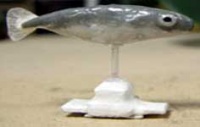The robot opens up new possibilities for studying fish behaviour and group dynamics, helping to predict fish migration routes and assessing the impact of human intervention on fish populations.
’We’ve proven it’s possible to use robotic fish to study relationships between individual fish and shoals,’ said PhD student Jolyon Faria, who led the experiments.
’Because the robotic fish is accepted by the shoal, we can use it to control one or several individuals, which allows us to study quite complex situations such as aggressive, cooperative, anti-predator and parental behaviour.’
The computer-controlled replica - dubbed Robofish by its creators John Dyer, Dr Dean Waters and Natalie Holt - is a plaster-cast model of a three-spined stickleback with an acetate fin, painted to mimic the colouration and markings of a real fish. The scientists needed to prove that Robofish was accepted into the group sufficiently for the fish to respond to the robot like a normal shoal member.
’Although Robofish looked like a stickleback to us, we weren’t sure whether the other fish would see it in the same light,’ explained Jolyon. ’We also thought there might be a problem with the smell, as fish use chemical cues in the water to identify other shoal members. In the end, Robofish was accepted straight away - though we did trial various models until we found one that worked the best.’

Robofish was placed in a tank with either single fish or a group of 10 and then programmed to follow a set path at a slightly faster speed than normal fish. The aim was to see if Robofish could tempt other fish to leave the tank’s refuge area and convince its companions to make a 90-degree turn.
Single fish left the refuge much sooner if Robofish instigated the move than they would on their own, though groups of fish left quite quickly without other motivation. Robofish was able to persuade both single fish and groups to make a turn. However, the longer time the fish spent in the tank, the less likely they were to display shoaling activity either on their own or in response to Robofish.
’Because Robofish moved faster and without stopping and tended to be at the front or on the edge of the shoal, the other fish saw it as bold and definite in its actions, which encouraged them to follow,’ said Faria. ’The fish were more easily influenced by a bolder member when they were nervous in new surroundings. Once they’d got used to the tank, they moved round quite happily to explore, rather than moving in unison as they did at the start.’
The experiments - funded through the Biotechnology and Biological Sciences Research Council and the EPSRC - have also allowed the researchers to answer a long-standing question of group dynamics: whether an individual’s ability to influence a group is dependent on how close together its members are.
In fact, when Robofish turned, its nearest neighbour did turn first, but it made no difference whether they were 9cm or 33cm away from the robot. Most models of group dynamics are based on the assumption that the closer you are to your neighbour the more influence you have, but this study has added weight to the argument that relative, rather than metric, distance is more important.




Red Bull makes hydrogen fuel cell play with AVL
Formula 1 is an anachronistic anomaly where its only cutting edge is in engine development. The rules prohibit any real innovation and there would be...